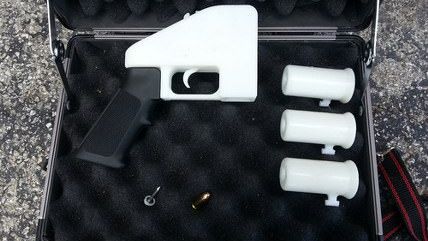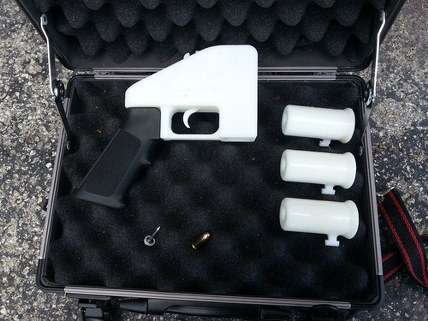European Cops Join Freakout Over 3D-Printed Guns, Admit They're Beyond Control


Europeans may be a little late to join the international panic by government officials over the ability of 3D printing to render their gun restrictions moot, but they're piling on in fine style. Authorities in several countries have purchased consumer-grade 3D printers to test the premise that you can make a working firearm on the widgets. Not surprisingly, the answer is resounding: "oh shit." And now they're wondering if there's a damned thing they can do about it.
For the New York Times, Georgi Kantchev writes:
PARIS — The gun fired four shots into a gelatin block. Each nine-millimeter bullet punched deep into the substance, which was meant to mimic the density of a human body.
For the experts at the Austrian Interior Ministry performing the test, it was a clear sign: This was a deadly weapon.
But it was no ordinary gun. The officials had downloaded the gun's digital blueprints from the Internet and "printed" the weapon on a type of 3-D printer that any person could buy online for about $1,360. It took the Austrian authorities 30 hours, and maybe $68 worth of plastic polymer, built up layer by layer according to the software instructions, to make the gun.
"Our interest was to see if the manufacturing of a working gun using this technology is possible," said Karl-Heinz Grundböck, a spokesman for the Austrian Interior Ministry, which performed the test in May. "The answer was a very clear 'Yes.' "
German police are also making their own 3D guns, as is the European Union's Europol—apparently in the hope that if they try it often enough, it won't work. Printing a gun at home is already illegal throughout the EU, but as Troels Oerting Joergensen, head of the European Cybercrime Centre at Europol, tells the Times, "It is very difficult to do anything about it. Of course you can say that it is illegal, but as with everything else on the Internet, you can always get it from somewhere."
That's pretty similar to what the U.S Department of Homeland Security told law enforcement agencies a few months ago, when it issued a bulletin saying, "Proposed legislation to ban 3D printing of weapons may deter, but cannot completely prevent their production." DHS added, "limiting access may be impossible."
As I've written before, European civilans aren't so gun averse as their (or our) politicians like to pretend. In 2003, The Small Arms Survey, based in Switzerland, estimated that there were a minimum of 1.4 million unregistered (illegal) firearms in Austria, where that late-to-the-party, 3D-printed Liberator pistol was tested. The latest estimate, from 2011, of total guns in the country is 2.5 million, with roughly 30 guns per 100 civilians (the SAS guesstimates the U.S. to have about 89 guns per 100 civilians). Germany is estimated to have between 17 and 20 million unregistered guns, with a total of 25 million in civilian hands. That's also 30 guns for every 100 civilians, with a majority of them illegally owned.
So Europeans are interested in firearms, and not so rigidly law-abiding about acquiring and keeping them. Given the relatively restrictive laws that prevail on most of the continent, that may well be a ripe environment for DIY 3D-printing projects—even riper than the comparatively permissive legal environment in the U.S.
More Reason coverage of 3D-printed guns here.


Show Comments (52)